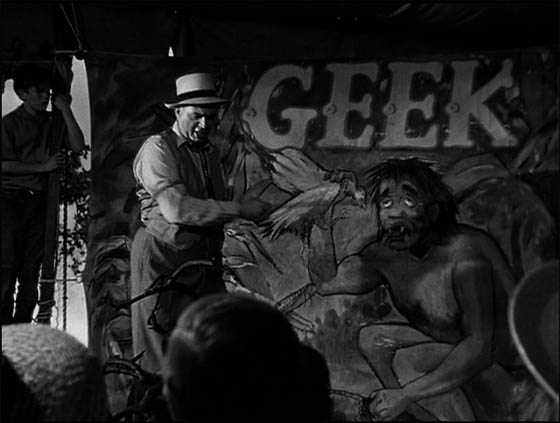 They didn’t call them noirs then; they were just crime pictures – cheap, pulpy, sensationalistic. The papers turned up their noses but audiences flocked to them, so studios kept making them. But if we didn’t have crime pictures as deeply strange and disturbing as Nightmare Alley (1947), the French critics wouldn’t have had such fodder for their essays on this new, perverse, cynical American genre. This film, indeed, goes further than most of the film noirs dared, and it’s also one of the very best. I’d easily place it near the top of a list that would include Double Indemnity (1944), Phantom Lady (1944), Detour (1945), The Third Man (1949), Gun Crazy (1950), Kiss Me Deadly (1955), and Touch of Evil (1958). In other words, if you’re new to noir, here’s as good a place as any to start. It’s bizarre, funny, kaleidoscopic, and has a black, black heart.
They didn’t call them noirs then; they were just crime pictures – cheap, pulpy, sensationalistic. The papers turned up their noses but audiences flocked to them, so studios kept making them. But if we didn’t have crime pictures as deeply strange and disturbing as Nightmare Alley (1947), the French critics wouldn’t have had such fodder for their essays on this new, perverse, cynical American genre. This film, indeed, goes further than most of the film noirs dared, and it’s also one of the very best. I’d easily place it near the top of a list that would include Double Indemnity (1944), Phantom Lady (1944), Detour (1945), The Third Man (1949), Gun Crazy (1950), Kiss Me Deadly (1955), and Touch of Evil (1958). In other words, if you’re new to noir, here’s as good a place as any to start. It’s bizarre, funny, kaleidoscopic, and has a black, black heart.
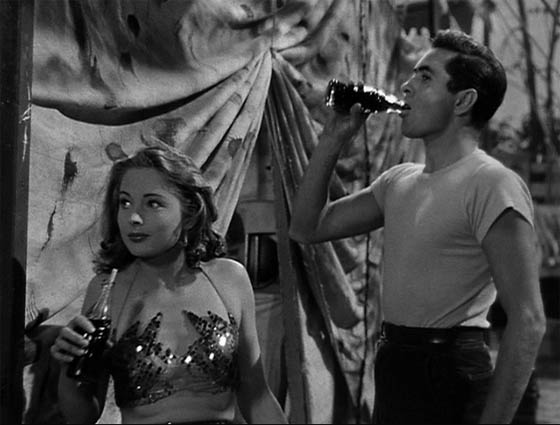
Handsome Tyrone Power was best known for his swashbuckling roles in films like The Mark of Zorro (1940), so he was an unusual choice for the role of Stan Carlisle, a sleazy carny with a talent for con games. Of the Twentieth Century Fox contract players, Dana Andrews or Richard Widmark would typically get cast in this kind of part; but Power brings a charisma that is appropriately hypnotic. Carlisle works at a traveling carnival, closely studying the mentalist act of Zeena (Joan Blondell) and her assistant/romantic partner Pete (Ian Keith). Blondell was just past forty, and she plays her part with a practiced confidence graced with a barely-concealed panic; she touched fame and wealth once, but now her act is strictly for the cheap seats, and she has little hope of getting loose of the carny business. Still, observe her professional hucksterism, and how efficiently she cons the yokels, after Stan gives her a grand introduction:
Stan seduces Zeena, but all he’s really interested in is “the Code” – not the famous self-help book, but a brilliant mentalist method that Zeena and Pete once used when their act was bigger than a carnival could contain. Zeena would have the audience members write questions on a card; then Pete would walk amongst them, keeping the card hidden from Zeena, and ask her to answer the question. But the two memorized an elaborate system of hidden signals – the choice of words, the number of words, the inflection of words – that would enable Zeena to deduce exactly what she needed to say to give the impression of psychic powers. Now Stan implores her to teach him the act: as an insurance method, he assures her, in case something should happen to Pete. And Pete is ill; as evidenced in the above clip, he’s an alcoholic drinking himself slowly to death. One evening, Stan takes pity on Pete and slips him what he thinks is moonshine to help him recover from the shakes; but he reaches into the wrong trunk, and accidentally hands Pete the bottle of pure alcohol that Zeena uses to “burn the cards” for her act. By the next morning, Pete is dead, and Stan is overwhelmed with guilt.
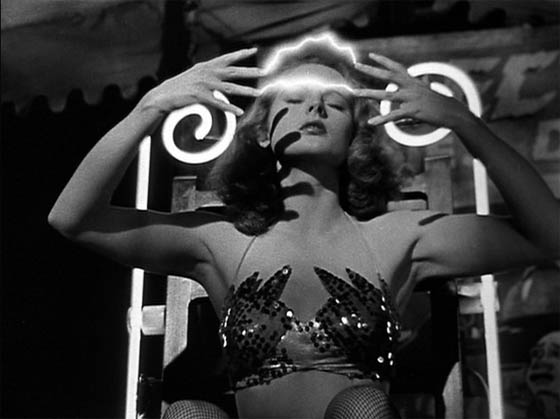
Nevertheless, with Pete out of the way, he finally convinces Zeena to teach him “the Code.” Assisting in the lessons is a young and pretty performer named Molly (Coleen Gray, Kiss of Death), who has a crush on Stan, much to the consternation of her strongman guardian, Bruno (noir veteran Mike Mazurki). Molly is “Electra,” who sits upon a throne and allows an electric current to pass through her body and between her hands; as Stan suavely explains to a sheriff who threatens to arrest Molly for wearing skimpy clothing: “The electricity would ignite any ordinary fabric. And only by wearing the thinnest covering can she avoid bursting into flame.” The sheriff has come to shut down the carnival, but Stan smooth-talks him out of it by pretending to read his mind and providing a spiritual comfort one would expect from a pastor in church; as the sheriff staggers away in a state of catharsis, Stan returns to his fellow carnies as a hero. Soon enough he’s making out with Molly when Zeena and Bruno are safely out of sight.
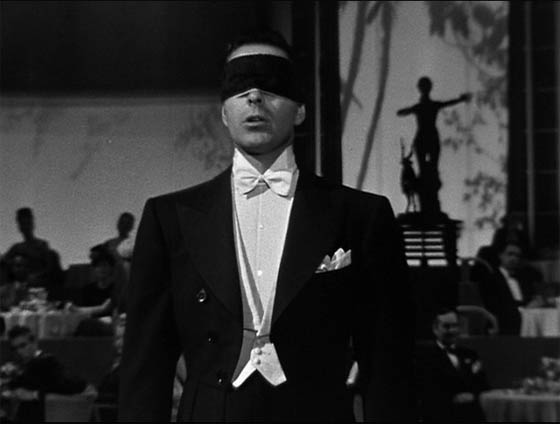 Trouble is, Molly can’t lie like Stan Carlisle can, and soon Bruno is forcing the two to get married. (Does this imply that Stan took Molly’s virginity? Needless to say, we don’t see that part.) And look at poor Joan Blondell. She underplays the revelation with a subtle look of disappointment; contrary to expectations, she doesn’t fight for Stan, but surrenders him to the younger, prettier woman as the dreary inevitable. This isn’t the worst of his betrayal, however. He and Molly take the “Code” to the big city, and are soon performing the plagiarized act before high-paying customers at a luxury hotel. So amazing is “The Great Stanton” that he even susses out an amateur con artist in the audience. Psychoanalyst Lilith (Helen Walker), hoping to prove the psychic a fraud, writes down the question: “Do you think my mother will recover from her present illness?” Stan responds that it’s a trick question; her mother is dead. He’s only guessing, but he can smell a con a mile away. As he later explains to her in person, “It takes one to catch one.”
Trouble is, Molly can’t lie like Stan Carlisle can, and soon Bruno is forcing the two to get married. (Does this imply that Stan took Molly’s virginity? Needless to say, we don’t see that part.) And look at poor Joan Blondell. She underplays the revelation with a subtle look of disappointment; contrary to expectations, she doesn’t fight for Stan, but surrenders him to the younger, prettier woman as the dreary inevitable. This isn’t the worst of his betrayal, however. He and Molly take the “Code” to the big city, and are soon performing the plagiarized act before high-paying customers at a luxury hotel. So amazing is “The Great Stanton” that he even susses out an amateur con artist in the audience. Psychoanalyst Lilith (Helen Walker), hoping to prove the psychic a fraud, writes down the question: “Do you think my mother will recover from her present illness?” Stan responds that it’s a trick question; her mother is dead. He’s only guessing, but he can smell a con a mile away. As he later explains to her in person, “It takes one to catch one.”
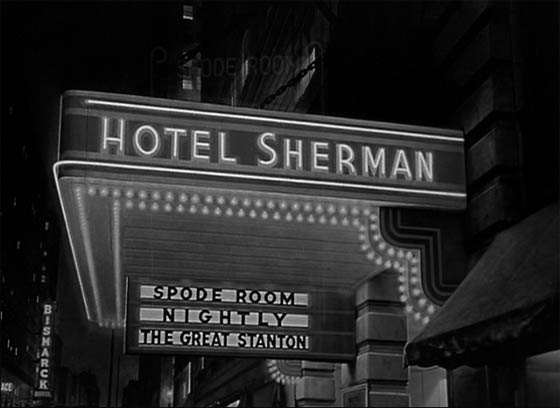 Stan is on a rapid ascent, and his success is fueled by his preacher-style cadence and Biblical phrasings. He is, essentially, an Elmer Gantry, propped up by true believers and basking in the glory. As he begins to promise his followers that he can communicate with the dead (for there’s bigger money in that racket), it’s difficult to not think of John Edward, the contemporary psychic whose bestsellers and long-running television series (Crossing Over with John Edward) made him a mammoth celebrity in the late 90’s and early 00’s. Penn and Teller devoted an early episode of their series Bullshit! to explaining how psychics like John Edward work, but that same explanation is here, decades earlier, in Nightmare Alley. Make generalizations and work upon the emotions of the mark. Let them do the heavy lifting; you just prod them in the right direction. Even Pete, drunk and finishing off the bottle which will end his life, manages to briefly convince Stan that he’s using psychic powers to peer into his childhood; just as Stan takes the bait, Pete scoffs, “Every boy has a dog.”
Stan is on a rapid ascent, and his success is fueled by his preacher-style cadence and Biblical phrasings. He is, essentially, an Elmer Gantry, propped up by true believers and basking in the glory. As he begins to promise his followers that he can communicate with the dead (for there’s bigger money in that racket), it’s difficult to not think of John Edward, the contemporary psychic whose bestsellers and long-running television series (Crossing Over with John Edward) made him a mammoth celebrity in the late 90’s and early 00’s. Penn and Teller devoted an early episode of their series Bullshit! to explaining how psychics like John Edward work, but that same explanation is here, decades earlier, in Nightmare Alley. Make generalizations and work upon the emotions of the mark. Let them do the heavy lifting; you just prod them in the right direction. Even Pete, drunk and finishing off the bottle which will end his life, manages to briefly convince Stan that he’s using psychic powers to peer into his childhood; just as Stan takes the bait, Pete scoffs, “Every boy has a dog.”
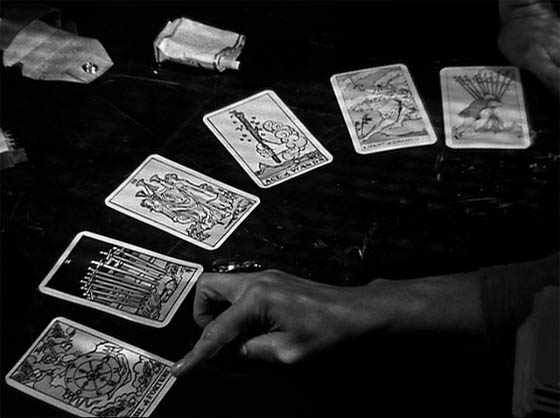 Stan’s listening. As he rises into the status of a minor celebrity, he becomes known as the “Miracle Worker.” He’s warned of a hard fall by Zeena, who returns with Bruno in tow, for an unwelcome visit to the luxury suite of Stan and Molly. She reads his Tarot, and he draws the Hanged Man – worse, he drops the card on the floor, which (we’re told) is a terrible omen. The last time this happened, Pete ended up dead; now it’s Stan’s turn for an evil fate. The soundtrack also drops warnings that something very, very bad is going to happen. Every time Stan is overcome with anxieties, director Edmund Goulding subtly overlays the hysterical cries of the carnival geek, who – as Stan watched one night – went mad, and ran raving into the darkness. We never see the geek’s act, but we’re told what it entails, and that’s enough. A man gets low, finds himself with no recourse, and he might end up with such a job. Stan, even at the height of his success, is haunted by this penalty of failure. Goulding’s experimental touch with the sound design here presages the work of David Lynch, and indeed, this is a very Lynchian noir.
Stan’s listening. As he rises into the status of a minor celebrity, he becomes known as the “Miracle Worker.” He’s warned of a hard fall by Zeena, who returns with Bruno in tow, for an unwelcome visit to the luxury suite of Stan and Molly. She reads his Tarot, and he draws the Hanged Man – worse, he drops the card on the floor, which (we’re told) is a terrible omen. The last time this happened, Pete ended up dead; now it’s Stan’s turn for an evil fate. The soundtrack also drops warnings that something very, very bad is going to happen. Every time Stan is overcome with anxieties, director Edmund Goulding subtly overlays the hysterical cries of the carnival geek, who – as Stan watched one night – went mad, and ran raving into the darkness. We never see the geek’s act, but we’re told what it entails, and that’s enough. A man gets low, finds himself with no recourse, and he might end up with such a job. Stan, even at the height of his success, is haunted by this penalty of failure. Goulding’s experimental touch with the sound design here presages the work of David Lynch, and indeed, this is a very Lynchian noir.
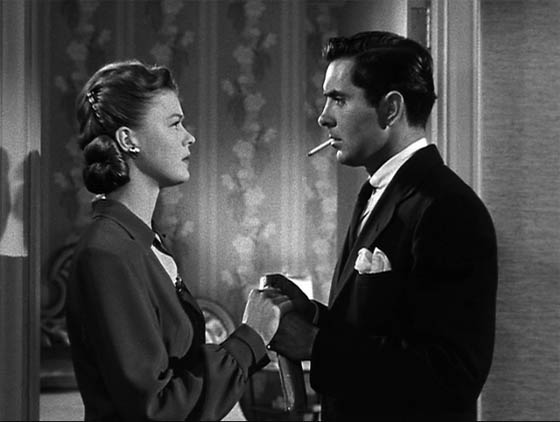 Each stage of Stan’s journey is signaled by the arrival of another woman; he uses Zeena to acquire the “Code” before abandoning her, and uses the younger, prettier Molly to work his tricks on the upper-class. But it’s Lilith – sophisticated, reserved, intelligent – who becomes the femme fatale that ends him. Behind Molly’s back, he pays visits to Lilith, and convinces her to betray her profession and assist him in the greatest con of all. The penultimate stage of this ever-shapeshifting film most closely resembles the work of James M. Cain, author of The Postman Always Rings Twice and Double Indemnity (novels which go to great lengths to explain why insurance fraud isn’t as easy as it looks). Nightmare Alley is actually based on a novel by William Lindsay Gresham, which I haven’t read, but Stan Carlisle embodies the typical Cain protagonist: an antihero who sets aside conscience for material gain. Unfortunately, he still has Molly at his side – and she does have a heart. With Molly on one side and Lilith on the other, the Great Stanton is set to take a hard, hard fall.
Each stage of Stan’s journey is signaled by the arrival of another woman; he uses Zeena to acquire the “Code” before abandoning her, and uses the younger, prettier Molly to work his tricks on the upper-class. But it’s Lilith – sophisticated, reserved, intelligent – who becomes the femme fatale that ends him. Behind Molly’s back, he pays visits to Lilith, and convinces her to betray her profession and assist him in the greatest con of all. The penultimate stage of this ever-shapeshifting film most closely resembles the work of James M. Cain, author of The Postman Always Rings Twice and Double Indemnity (novels which go to great lengths to explain why insurance fraud isn’t as easy as it looks). Nightmare Alley is actually based on a novel by William Lindsay Gresham, which I haven’t read, but Stan Carlisle embodies the typical Cain protagonist: an antihero who sets aside conscience for material gain. Unfortunately, he still has Molly at his side – and she does have a heart. With Molly on one side and Lilith on the other, the Great Stanton is set to take a hard, hard fall.
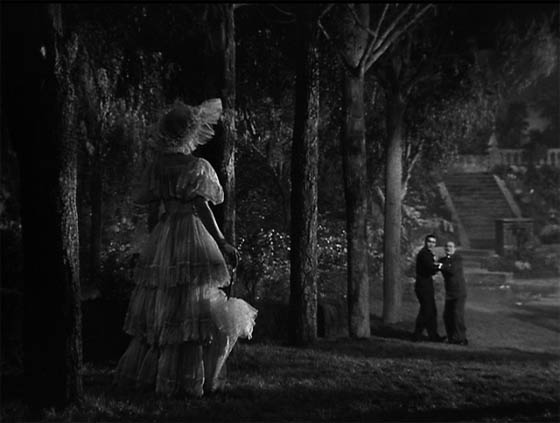 There is a moral, as the Hays Code demanded; crime had to pay…though did it ever pay this hard? Film noirs took that Hays mandate and pushed it to the limit. Their characters ventured down dark alleys in pursuit, often, of immoral goals; but doom ever lurked over their necks like a guillotine blade. Nightmare Alley is not just an exemplary noir, but illustrates the genre’s themes most starkly. Here, the carnival replaces the typical seedy streets of the crime thriller, but it proves just as shadowy and morally fraught. Goulding lets his camera snake in and out of the carnival tents, swooping from the stage into the throng of spectators, constantly shifting from those who watch to those who plot the spectacle from behind the scenes. Stan, addicted to the carny life, confesses to Zeena: “Lady, I was made for it. I had all kinds of jobs before this one came along; none of them were anything but jobs. But this gets me…the crowds, the noise, the idea of keeping on the move. Seeing those yokels out there gives you a sort of superior feeling, as if you were on the know, and they were on the outside looking in. Kind of hard to explain, but I like it.” Nightmare Alley proves just as darkly addictive.
There is a moral, as the Hays Code demanded; crime had to pay…though did it ever pay this hard? Film noirs took that Hays mandate and pushed it to the limit. Their characters ventured down dark alleys in pursuit, often, of immoral goals; but doom ever lurked over their necks like a guillotine blade. Nightmare Alley is not just an exemplary noir, but illustrates the genre’s themes most starkly. Here, the carnival replaces the typical seedy streets of the crime thriller, but it proves just as shadowy and morally fraught. Goulding lets his camera snake in and out of the carnival tents, swooping from the stage into the throng of spectators, constantly shifting from those who watch to those who plot the spectacle from behind the scenes. Stan, addicted to the carny life, confesses to Zeena: “Lady, I was made for it. I had all kinds of jobs before this one came along; none of them were anything but jobs. But this gets me…the crowds, the noise, the idea of keeping on the move. Seeing those yokels out there gives you a sort of superior feeling, as if you were on the know, and they were on the outside looking in. Kind of hard to explain, but I like it.” Nightmare Alley proves just as darkly addictive.









